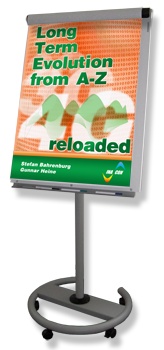 LTE from A-Z - Reloaded
LTE from A-Z - Reloaded
[2-day course, Euro 2,350.- (net) per participant]
 Training Course Description
Training Course Description

- This training course addresses the needs of everybody who needs to understand the technology and concepts of LTE as the future 4G standard of 3GPP.
- After the general introduction to 4G standards is given, the training course starts with an introduction of the requirements of LTE, as well it provides insight to the most relevant changes to L1/L2/L3 and the network architecture of E-UTRAN compared to UMTS, HSDPA, and HSUPA.
- This part ends with an overview of the basic technology trends visible in LTE.
- The following part presents important characteristics of the key layer 1 technologies: OFDM and MIMO.
- The training course continues with a detailed description of the LTE L1. Among others we evaluate in detail the application of essential technologies like OFDMA for the downlink and SC-FDMA for the uplink in LTE as well as the LTE frame structure.
- This part concludes with the discussion of the physical layer procedures like power control (PC), timing advance control, cell search, random access, and the used antenna technology.
- The next chapter evaluates in detail the higher layer protocols of E-UTRAN such as MAC (Medium Access Control), RLC (Radio Link Control), RRC (Radio Resource Control), PDCP (Packet Data Convergence Protocol) as well as security and quality of service in LTE.
- This part includes the discussion of NAS (Non- Access Stratum) procedures such as mobility management and the various kinds of handover to be supported by LTE.
- The final chapter is presenting selected E-UTRAN scenarios which should give the participants an understanding how the protocols of LTE work together across the different network elements. We are focusing on RRC connection establishment, PDP context establishment, sell reselection, and handover scenarios. Finally the journey of a TCP MTU through the protocol layers is described in detail.
As in all our training courses, we integrated several interactive exercises for a perfect learning experience.
Some of your questions that will be answered
- What is LTE and why it is introduced in the first place?
- What are the requirements for LTE and how do they differentiate from those of UMTS?
- What are the key characteristics of LTE’s (E-UTRAN’s) layer 1 and layer 2/3?
- How does the LTE and SAE (System Architecture Evolution) evolved mobile radio network look like?
- What key development trends are manifested in LTE?
- How do the basic physical layer technologies of LTE like OFDM and MIMO work?
- How the physical frame structure is facilitating the use of a flexible bandwidth allocation?
- How do the digital signal processing chains of uplink and downlink look like and what is their difference with respect to conventional mobile radio systems?
- How the physical layer procedures work in LTE?
- How the throughput of the UE categories can be calculated?
- What are the tasks of the higher layer protocol entities and functions of the enhanced node B: MAC, RLC, PDCP, and RRC?
- What are the used concepts for mobility in LTE?
- How does LTE manage the most relevant scenarios like initial context setup, PDP context establishment and hand over?
- How in detail the TCP packets travel through the protocol layers?
 Who should attend this class?
Who should attend this class?
- Everybody who needs to design Long Term Evolution capable UE’s and network equipment.
- Operators who need a detailed understanding of Long Term Evolution.
- Test engineers who need to integrate Long Term Evolution equipment and UE’s.
 Pre-Requisites
Pre-Requisites
- The student should possess detailed knowledge of wireless communications, particularly within the area of digital signal processing in wireless communications.
- This experience should stem from hands-on work in the area of design, integration, test or troubleshooting of GSM, CDMA or WCDMA-equipment.
- Comprehension of different digital modulation schemes like QAM or PSK and of different multiple access schemes like TDMA, FDMA and CDMA is required.
 Training Course Target
Training Course Target
- The student will obtain detailed understanding of the LTE / E-UTRAN standard and the related procedures and network operation and architectures.
- The student is enabled to access the LTE technology with regard to deployment issues.
- After the training course the student will be enabled to design, test and operate LTE networks and UE’s.
 Training Course Duration
Training Course Duration
- 2 days
v3.110
ℹ️ Try out the updated search below!
Search:
More Info:
Detailed ToC of this training course
Schedule of this training course
Extract of this training course
Buy this book
Buy this book as eBook
INACON eBooks
Please have a look at our full offer

